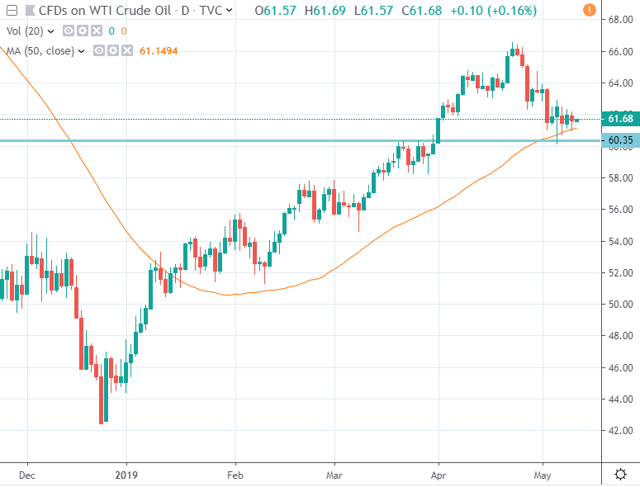[ad_1]
A few weeks ago, I wrote a piece about the United States 12-Month Oil ETF (USL) in which I examined the mechanics of the ETF to generate a basic working framework of when to hold and avoid the instrument. My basic findings upon researching the ETF is that since USL holds 12 months of futures, outright volatility is diminished and returns are heavily dependent on roll yield. In this piece, I will discuss how the fundamentals for crude oil have changed in such a way that buying USL now makes for a good play on WTI structure and sentiment.
Roll Yield
Before jumping into the fundamentals and technicals of USL, we need a quick primer/refresher on roll yield. The basic issue when it comes to an ETF that tracks futures is that futures expire while ETFs do not. This means that the ETF has to employ a systematic method of moving positions from one futures contract to another futures contract to avoid holding into expiry.
The futures market has an interesting feature in that in general prices later out on the curve tend to converge towards spot price. This means that if a market is in contango (front month under back months), roll yield will be negative as higher priced contracts tend to approach front month contracts as expiry approaches. In backwardation, the opposite generally holds true.
USL is a massive play on market structure in that it takes a position in the front 12 months of WTI futures and rolls the position as expiry approaches. This means that a substantial percentage of return is subject to the action across the curve and whatever happens to market structure will reflect through into the returns of USL. Also, since volatility tends to clump at the front of the curve, this means that the returns and losses from USL will be less on an absolute basis than a position simply tracking the front of the curve. This implications of this are pretty simple – if we can predict what is going to happen with market structure, we can likely predict a substantial portion of USL’s future returns. We’re in luck because through fundamental and price analysis, we can do just this.
Technicals
Before jumping into the fundamental analysis of the oil markets, we should examine the technical landscape and market sentiment present in WTI. The fact of the matter is that fundamentals never appear in isolation but need to be framed up in light of market sentiment and unfolding market action.
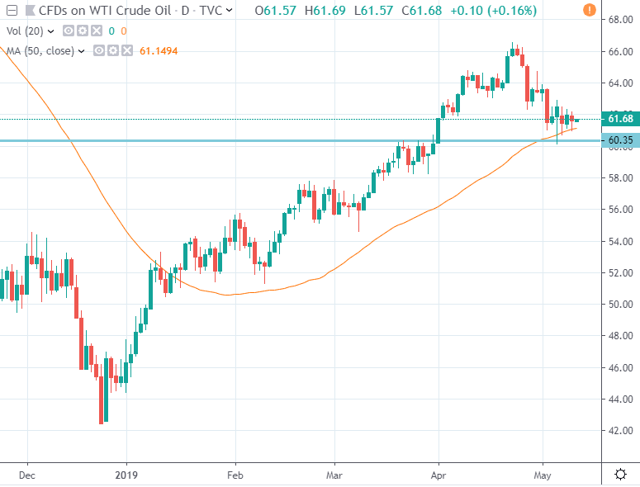
The current technical picture is that price is currently testing support in an established uptrend. Since the beginning of 2019, we have seen flat price WTI rally strongly as the oil markets recovered from a temporary oversupply situation and inventories pulled back towards the 5-year average. The recent market action is currently finding support at the confluence of the 50-day simple moving and the prior resistance established in late April.
From a technical perspective, this is a textbook extended pullback which has not substantially broken the trend which means that the technical outlook remains bullish. If we see sustained trading action below the 50-day simple moving average (around $61/bbl) then the trend will be broken and we will need to reassess the forecast.
Fundamentals
The technical picture lends significance to the EIA release from this week in which crude inventories drew 3.9 million barrels, breaking the trend of two back-to-back builds. This draw was unusually strong for this time of the year and shows underlying demand.
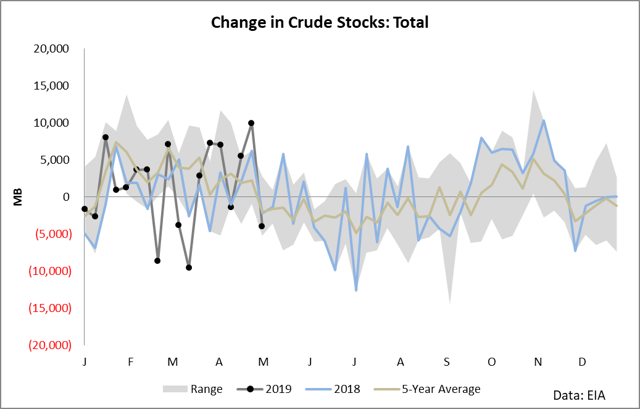
This switch into bullishness comes at the technically-significant resistance level previously discussed which indicates that underlying sentiment remains bullish.
When we examine the larger fundamental thesis for crude oil, we see that the current balance is such that while we are above the 5-year average, we are entering a period in which stocks tend to fall.
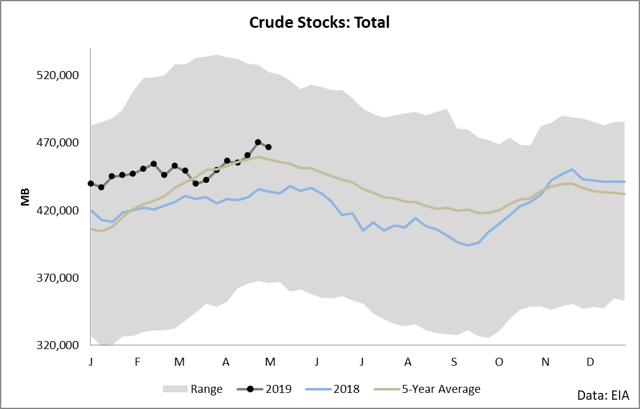
The draw this week was primarily fueled by a snap-back in crude imports, which has remained an essential driver of the bullishness throughout this year.
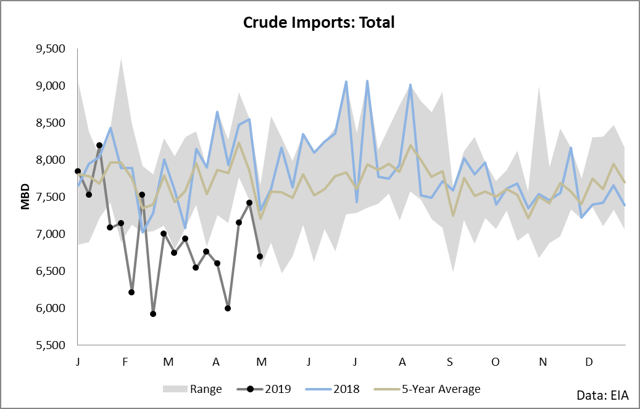
Another noteworthy factor regarding the current dynamic at work in the United States is the current status of refinery utilization.
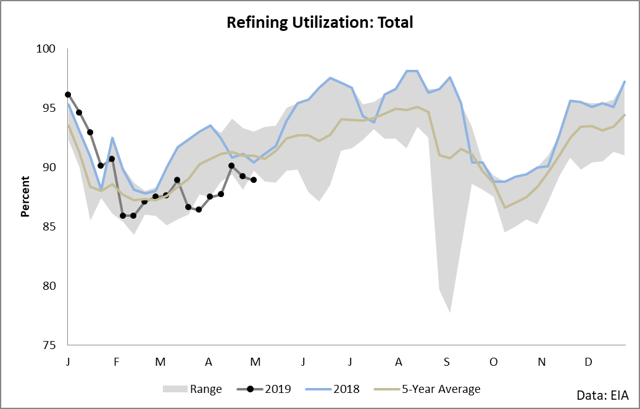
Refining runs are the primary driver of demand for crude oil and the current run rates are frankly terrible for this time of year. It appears refineries on whole have not reached out to capture the widening product cracks and in the process are contributing to declines in stocks during the time of year in which we enter peak demand.
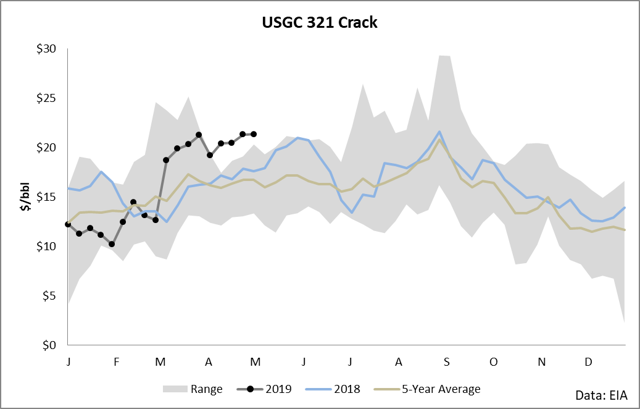
This basic problem will be driving fundamentals in the immediate future and will in all likelihood sustain the bullish trend in force since the beginning of the year. Simply put, refineries are going to have to increase runs very soon to avoid pressuring product stocks even more and when these runs increase, crude prices will likely increase as well.
Putting it all together
USL is poised to benefit in a few tangible ways. First, roll yield is such that while the market is in backwardation, shares will likely increase due to its massive bet on structure. The market is currently in contango in the front but backwardation further out in the back. As price continues to appreciate, we will likely see backwardation enter the front as the market signals a demand for prompt barrels.
Next, the underlying technical trend is bullish for WTI. Even though USL is holding 12 separate months of futures, these are all WTI futures and the picture for WTI is bullish. The market is currently holding support at prior resistance and short-term fundamentals are supportive of additional upside.
Finally, the fundamental picture of North American crude markets is such that we have structural bullishness built into the next 3-4 months and the market does not appear to be ready for it. This will likely fuel WTI’s rally and propel prices to new highs for the current trend over the coming weeks.
It’s a great day to buy USL.
Disclosure: I/we have no positions in any stocks mentioned, and no plans to initiate any positions within the next 72 hours. I wrote this article myself, and it expresses my own opinions. I am not receiving compensation for it (other than from Seeking Alpha). I have no business relationship with any company whose stock is mentioned in this article.
[ad_2]
Source link Google News

